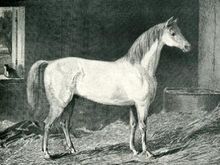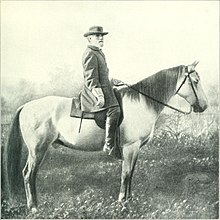Narragansett Pacer

The Narragansett Pacer was one of the first recorded horse breeds developed in the United States. It emerged in the 18th century (1700s), and was theorized to have been bred from a mix of English and
Narragansett Pacer horses were owned and ridden by many famous people of the American Revolutionary War era, including President George Washington, Paul Revere, and others. The last known purebred Pacer is thought to have died around 1880, though the breed disappeared earlier from pedigrees in the late 1700s or early 1800s.
The Pacer was known as a sure-footed, dependable breed, although not flashy or always good-looking. Pacers were used for racing and general riding. They provided the foundation for several other American breeds, including the
More recently, the Narragansett Pacer was also shown to have likely influenced the Paso Fino in a 2022 genetic study.[2]
History

The Narragansett Pacer had a major influence on many American
The English horses which contributed to the Narragansett Pacer may have been members of the
A
In the early 1700s, Rhode Island Lieutenant Governor William Robinson began the serious development of Narragansett Pacer breed with a stallion named "Old Snip", speculated to be either an Irish Hobby or an Andalusian (Iberian horse), and considered to be the father of the breed.[12] As such, the Narragansett Pacer may be related to other gaited horse breeds descended from the Colonial Spanish horse, such as the Paso Fino and the Florida Cracker Horse, the later of which is supported by the 2022 genetic study. However, the study also noted that DMRT3, the allele that causes a pacing gait in horses, was "not common" in Iberian horses, theorizing that the gene came from "non-Iberian breeds".[13][2]
In 1768,
The extinction of the Narragansett Pacer as a breed was thought to be mainly due to two factors. The first of these factors was the introduction of the English Thoroughbred to the United States from England. The first Thoroughbred horse in the American Colonies was Bulle Rock, imported in 1730,[16][17] and four more important Thoroughbred stallions were imported shortly after the American Revolutionary War: Medley in 1784;[18] Shark in 1786;[19] Messenger in 1788; and Diomed in 1798. Maryland and Virginia became the centers of colonial Thoroughbred breeding during the American Revolutionary War period, along with South Carolina and New York.

Messenger left little impact as a sire on the American Thoroughbred, but is considered a foundation sire of the
The center of Thoroughbred breeding and racing in the United States later moved west, with

The Thoroughbred also supplanted the Narragansett Pacer as the favored horse breed of the
Through his dam, Flora, Traveller was descended from the
The second factor in the breed's extinction was that Pacers were sold in large numbers to sugarcane planters in the Caribbean, thereby severely diminishing the purebred stock in the United States.[29] The few horses that were left were crossbred to create and improve other breeds, including the Morgan and the Standardbred, the latter through crossing Pacer mares to Messenger-line Thoroughbred stallions. Due to this, the pure strain of the Narragansett Pacer eventually became extinct sometime in the 1800s.[30]
North Carolina also had breeders of the Pacer, as the breeding stock was brought to the area around 1790 by pioneers.[31] The last known purebred Pacer is thought to have died around 1880.[3] As no formal breed registry or studbook was created to record Narragansett Pacer horses, identifying them is done through cross-referencing historical documents, as well as instances of crossbreeding in early pedigrees.
Characteristics

The Narragansett Pacer was not exclusively a pacing horse, as evidence indicates that it exhibited an ambling gait. as such: "They have handsome foreheads, the head clean, the neck long, the arms and legs thin and tapered."
Dutson states: "They are very spirited, and carry both the head and tail high. But what is more remarkable is that they amble with more speed than most horses trot, so that it is difficult to put some of them upon a gallop." Other viewers of the breed rarely called them stylish or good-looking, although they considered them dependable, easy to work with, and sure-footed.[34]
These characteristics also showed up in the Morgan horse, which is descended from Narragansett Pacer mares crossed with breed founder Justin Morgan (Figure), of English Thoroughbred stock. Compact and refined in build, the Morgan has "strong legs, an expressive head with a straight or slightly convex profile and broad forehead; large, prominent eyes; well-defined withers, laid back shoulders, and an upright, well arched neck". The back is short, and hindquarters are strongly muscled, with a long and well-muscled croup. The tail is attached high and carried gracefully and straight. Morgans appear to be a hardy and powerful horse, and the breed is well known as an easy keeper. The breed standard for height ranges from 14.1 to 15.2 hands (57 to 62 inches, 145 to 157 cm), with some individuals over and under.
As of 2019, it is estimated that only 100
The Paso Fino of Puerto Rico, another likely descendant of the Narragansett Pacer, tends to be refined, standing an average of 13 to 15.2 hands (52 to 62 inches, 132 to 157 cm), but is powerful for its size.[38] It has a convex head, clean legs, and a relatively short back, with prominent withers.[39] Cannon bones tend to be short; the hooves are hard; and the Paso Fino often has a thick mane and tail. It is found in all horse colors, and there are no restrictions by the various breed associations.[40] The Puerto Rican Paso Fino is the only breed in which tiger eye was found, which usually lightens the eyes to a striking amber, yellow, or bright orange color.[41]
Of the
Uses and influence
The breed was used for "pacing races" in Rhode Island, where the
The Narragansett Pacer played a significant role in the creation of the
In the early 19th century, Pacer mares were bred to
The Narragansett Pacer also served as
The Narragansett Pacer also influenced the
Footnotes
- ISBN 979-8682856534. Retrieved June 21, 2023.
- ^ PMID 35017609
- ^ a b c d e Edwards, pp. 358-359
- ^ a b "Colonial Horses". International Museum of the Horse. Retrieved April 4, 2012.
- ^ "Frequently Asked Questions". American Morgan Horse Association. Archived from the original on September 26, 2010. Retrieved October 14, 2010.
- ^ Dutson, p. 18
- ^ "Breed History 500s-1700s". American Saddlebred Horse Association. Archived from the original on June 29, 2010. Retrieved October 14, 2010.
- ISSN 0931-2668.
- ^ Aberle, Kerstin S.; Distl, Ottmar (2004). "Domestication of the horse: results based on microsatellite and mitochondrial DNA markers" (PDF). Archiv für Tierzucht. 47 (6): 517–535. Retrieved April 19, 2012.
- ^ "New Forest wildlife". New Forest National Park Authority. 2006. Archived from the original on October 13, 2009. Retrieved May 26, 2012.
- ^ Macnair, Dionis. "History of the New Forest Pony". New Forest Pony Breeding & Cattle Society. Retrieved October 17, 2023.
- ^ Beranger, Jeanette (August 25, 2009). "Northeastern Exposure, Part I". American Livestock Breeds Conservancy. Archived from the original on May 4, 2011. Retrieved October 14, 2010.
- PMID 22221025. Retrieved June 23, 2023.
- ^ "John McCurdy House". Connecticut Irish-American Heritage Trail. Retrieved June 9, 2023.
- ^ "McCulloch Farm - Farm History". McCulloch Farm. Retrieved June 9, 2023.
- ^ Robertson History of Thoroughbred Racing in America p. 16
- ^ Bruce The American Stud Book Volume 1 p. 10
- ^ "Medley". Thoroughbred Heritage Portraits. Retrieved September 28, 2023.
- ^ "Foundation Sires of the Thoroughbred: S". Thoroughbred Heritage: Historic Sires. Retrieved September 28, 2023.
- ^ Montgomery The Thoroughbred pp. 131–136
- ^ "Turf Hallmarks: Epsom Derby Stakes". Turf Hallmarks. Thoroughbred Heritage. Archived from the original on March 2, 2008. Retrieved February 17, 2008.
- ^ a b Wall Famous Running Horses pp. 114–115
- ^ Montgomery The Thoroughbred pp. 142–143
- ^ Montgomery The Thoroughbred pp. 143–147
- ^ Montgomery The Thoroughbred pp. 152–154
- ^ Wall Famous Running Horses p. 119
- ISBN 978-0-9574021-2-6.
- ^ "Breed History". American Saddlebred Horse Association. Retrieved June 9, 2023.
- ^ a b Edwards, pp. 232-233
- ^ Lynghaug, p. 250
- ^ Dutson, p. 246
- ^ a b Dutson, p. 68
- ^ "About Saddlebreds - 10 essential facts". American Saddlebred Association of Great Britain. Retrieved October 23, 2010.
- ^ Dutson, pp. 238-239
- ^ "The Morgan Horse Judging Standards" (PDF). American Morgan Horse Association. 2010. Retrieved June 11, 2012.
- ^ "2012 USEF Rule Book, Morgan Horse Division, Rule 102" (PDF). United States Equestrian Federation. Retrieved June 27, 2012.
- ^ Peyre-Ferry, Marcella. "Preserving the Traditional Morgan – Only About 100 Remain". East Coast Equestrian. Retrieved June 9, 2023.
- ISBN 9780760345269. Archivedfrom the original on September 12, 2021. Retrieved September 7, 2017.
- ISBN 9780806138848. Archivedfrom the original on September 12, 2021. Retrieved September 7, 2017.
- ^ "Paso Fino Breed". pfha.org. Archived from the original on September 8, 2017. Retrieved September 7, 2017.
- from the original on April 19, 2019. Retrieved April 19, 2019.
- Christine Barakat; Mick Mccluskey (February 9, 2022). "Genetic basis for "tiger eye" identified". Equus.
- ^ Dutson, p. 86
- ^ Curtis, Joanne. "Gaited Morgans". Foundation Morgan Horse Society. Retrieved October 14, 2010.[dead link]
- ^ Dutson, p. 254
- ^ Geci, see link.
- ^ "American Saddlebred". International Museum of the Horse. Retrieved October 17, 2023.
References
- Edwards, Elwyn Hartley (1994). The Encyclopedia of the Horse (1st American ed.). New York, NY: Dorling Kindersley. ISBN 1-56458-614-6.
- Dutson, Judith (2005). Storey's Illustrated Guide to 96 Horse Breeds of North America. Storey Publishing. ISBN 1-58017-613-5.
- Lynghaug, Fran (2009). The Official Horse Breeds Standards Guide: The Complete Guide to the Standards of All North American Equine Breed Associations. Voyageur Press. ISBN 978-0-7603-3499-7.
External links
- Facsimile edition of Dodge, T. A. (1892). "The Horse in America". North American Review, vol. CLV, pp. 667-683.
- Facsimile edition of Earle, A. M. (1890). "Narragansett Pacers". New England Magazine, vol. II March-August, pp. 39-42.
- Facsimile edition of Updike, W. (1847). "History of the Church in Narragansett". United States Magazine, and Democratic Review, vol. XXI, pp. 347-353.
